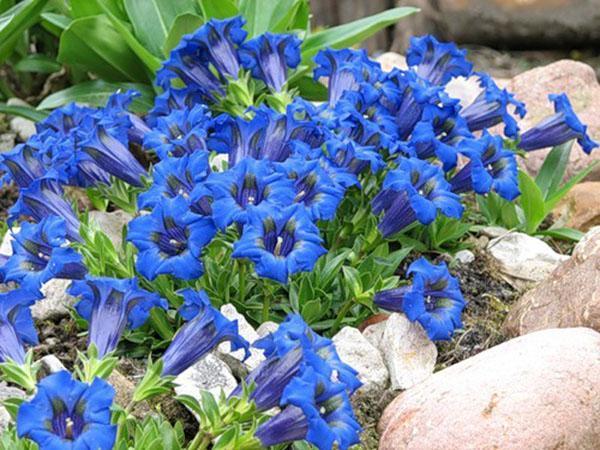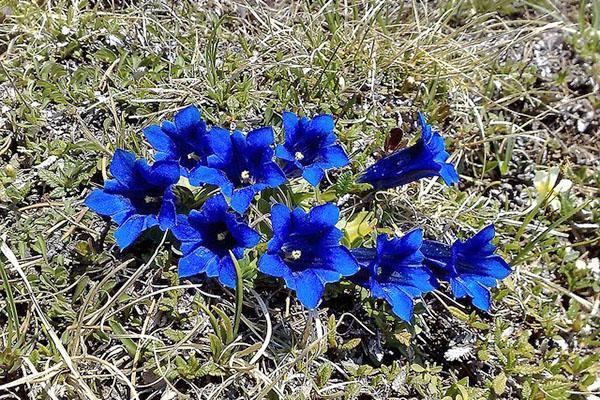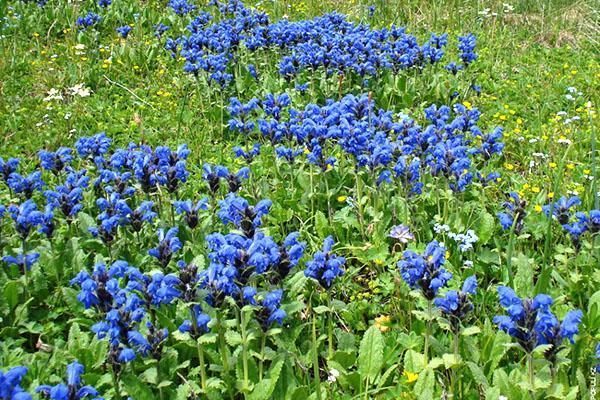We get acquainted with the wonderful varieties of gentian and their properties
 The gentian, whose photo is often used to create postcards, is not only a spectacular, but also a useful plant. It is a low-growing herbaceous shrub that can be annual or perennial. In nature, this flower grows everywhere, it is absent only in regions with a cold climate, where the soil is hidden under snow for most of the year. At home, it can be grown to decorate a garden or create a living carpet; small flowers will look no less attractive in pots. Gentian is also known in folk medicine - its range of uses includes various diseases of the digestive tract and respiratory system.
The gentian, whose photo is often used to create postcards, is not only a spectacular, but also a useful plant. It is a low-growing herbaceous shrub that can be annual or perennial. In nature, this flower grows everywhere, it is absent only in regions with a cold climate, where the soil is hidden under snow for most of the year. At home, it can be grown to decorate a garden or create a living carpet; small flowers will look no less attractive in pots. Gentian is also known in folk medicine - its range of uses includes various diseases of the digestive tract and respiratory system.
What is this plant?

The gentian is an outdoor herb that can be grown in almost any conditions.
Its main feature is bright flowers. They are small and can range in color from yellow to bright blue. A large number of inflorescences are formed on one bush, which appear and disappear during the warm season.
During the period of active flowering, the gentian looks bright and impressive in the photo. Its varieties may differ from each other, but they are all collected in one group due to similar botanical characteristics:
- the root is straight and strong, small branches extend from it;
- the main stem is straight and low;
- flowers are solitary, one inflorescence is formed on one shoot;
- after flowering, fruit-boxes are formed, in which there are then seeds for planting.
Visually and in the photo, the gentian is different. Some varieties are blue, blue or purple, others can acquire yellow and other shades. The flowering time also depends on the gentian variety. Early varieties are distinguished, which begin to bloom in spring, medium and late - only in summer or autumn.
Before choosing a variety, it is important to pay attention not only to its appearance, but also to the requirements for the climate and the flowering period.
Growing at home and care
 Under natural conditions, gentian can grow in harsh conditions and adapt even to cold climates, so caring for it is simple. However, in nature, plants choose only those areas in which they will grow most comfortably. When growing at home, you should take care of this yourself.
Under natural conditions, gentian can grow in harsh conditions and adapt even to cold climates, so caring for it is simple. However, in nature, plants choose only those areas in which they will grow most comfortably. When growing at home, you should take care of this yourself.
Plant propagation
 The gentian reproduces in two ways - vegetatively and with the help of seeds. The second method is suitable for all varieties, and you can harvest the seeds yourself. They can emerge within 6-12 months.
The gentian reproduces in two ways - vegetatively and with the help of seeds. The second method is suitable for all varieties, and you can harvest the seeds yourself. They can emerge within 6-12 months.  The process of growing gentian from seeds takes place in several stages:
The process of growing gentian from seeds takes place in several stages:
- stratification - freezing seeds for 1-3 months at a temperature of no more than 7 degrees;

- sowing can be carried out in the fall, while the seeds do not need to be placed deep in the ground, it is enough to scatter over the surface and press a little;
- when sowing in spring, it is important to maintain constant moisture;
- the first shoots appear in 2-3 weeks.
Vegetative propagation is not suitable for all varieties. Some of them can be propagated by cuttings. To do this, a shoot with several leaves is separated and placed in water until roots appear. Then it can be planted in open ground.
Some of them can be propagated by cuttings. To do this, a shoot with several leaves is separated and placed in water until roots appear. Then it can be planted in open ground.
Care advice
 Gentian care depends on its variety, but some requirements are suitable for all its varieties:
Gentian care depends on its variety, but some requirements are suitable for all its varieties:
- plants should be planted in areas that are exposed to direct sunlight (however, a variety such as gorseed gentian prefers partial shade);
- abundant watering - it is necessary to ensure that the upper layers of the soil are constantly moistened, but liquid stagnation should also not be allowed;
- flowers are unpretentious to the composition of the soil, but grow best on soils with neutral acidity;
- on insufficiently fertile soil, it is worth adding monthly mineral fertilizers for flowering garden plants (half of the dose indicated on the package is enough).
 There are both annual and perennial varieties of gentian. Even varieties that grow for several years are good at tolerating temperature changes and frost-resistant. They do not need to be pre-prepared for winter or covered from snow.
There are both annual and perennial varieties of gentian. Even varieties that grow for several years are good at tolerating temperature changes and frost-resistant. They do not need to be pre-prepared for winter or covered from snow.
Gentian in folk medicine
 The medicinal properties of gentian are due to its composition. It is used by healers against various diseases of the gastrointestinal tract, respiratory and other systems. As active ingredients, this plant contains glycosides - biologically active components that are involved in various vital processes.
The medicinal properties of gentian are due to its composition. It is used by healers against various diseases of the gastrointestinal tract, respiratory and other systems. As active ingredients, this plant contains glycosides - biologically active components that are involved in various vital processes.
The gentian has been used to treat a number of conditions:
- inflammatory processes of internal organs;
- cough;
- as an antiparasitic agent;
- with diseases of the joints;
- to relieve allergies and many other symptoms.
Broths of gentian have proven to be effective for improving appetite and as a general tonic. They are also taken for arthritis of various origins, for wound healing and to normalize digestion.
Contraindications to use
Despite the wide spectrum of action of gentian, it is not suitable for all patients. The herb can cause allergic reactions to any of its active ingredients. They are manifested by an increase in body temperature, deterioration of health, swelling of the mucous membranes and even the appearance of a rash on the skin. In addition, in case of serious disturbances in the work of internal organs, the decoction will not be as effective as pharmacy medicines.
The medicinal properties and contraindications of gentian are worth discussing with your doctor. Like any other folk and medical methods, it should be used only when indicated and after a preliminary examination.
Varieties and varieties
 The gentian family has more than 400 varieties and varieties. This diversity is due to the fact that flowers grow on different continents and are forced to adapt to different climatic conditions. For home cultivation, you can choose any of the varieties - it will not be difficult to provide the color with comfortable conditions.
The gentian family has more than 400 varieties and varieties. This diversity is due to the fact that flowers grow on different continents and are forced to adapt to different climatic conditions. For home cultivation, you can choose any of the varieties - it will not be difficult to provide the color with comfortable conditions.
Common gentian (pulmonary)
 The pulmonary gentian is a short plant that can grow up to 50-60 cm in height. It grows in open meadows and plains and tolerates frost well. The flowers are single, bright blue or blue. The shrub needs abundant watering, in nature it often grows in swampy areas.
The pulmonary gentian is a short plant that can grow up to 50-60 cm in height. It grows in open meadows and plains and tolerates frost well. The flowers are single, bright blue or blue. The shrub needs abundant watering, in nature it often grows in swampy areas.
Gentian yellow
 The yellow gentian is one of the largest varieties, it can grow up to 1.5 m. Differs in unusual flowering - individual flowers in complex inflorescences. They are colored bright yellow and appear in the second half of summer. In the photo, the yellow gentian looks bright and impressive.
The yellow gentian is one of the largest varieties, it can grow up to 1.5 m. Differs in unusual flowering - individual flowers in complex inflorescences. They are colored bright yellow and appear in the second half of summer. In the photo, the yellow gentian looks bright and impressive.
Gentian cruciform
 Cross-leaved gentian (cruciform) belongs to the late varieties. It has a straight, strong stem up to 50 cm in length, densely covered with green leaves. The flowering period begins in the second half or late summer. The cruciform gentian can be recognized by the characteristic color of the petals - they have a turquoise, purple or lilac hue.
Cross-leaved gentian (cruciform) belongs to the late varieties. It has a straight, strong stem up to 50 cm in length, densely covered with green leaves. The flowering period begins in the second half or late summer. The cruciform gentian can be recognized by the characteristic color of the petals - they have a turquoise, purple or lilac hue.
Dahurian gentian
 Daurian gentian is also one of the medium varieties that blooms in the second half of summer. Unlike other varieties, its stem is not strong enough, but it can reach 50 cm or more. Tall shrubs may have shoots on the ground. Leaves are pale green in color. The flowers are single, large, and have a bright blue color.
Daurian gentian is also one of the medium varieties that blooms in the second half of summer. Unlike other varieties, its stem is not strong enough, but it can reach 50 cm or more. Tall shrubs may have shoots on the ground. Leaves are pale green in color. The flowers are single, large, and have a bright blue color.
Gentian
 Gusset gentian is a late variety. Its stems are tall, straight, and can grow up to 80 cm with proper care and maintenance. In nature, it begins to bloom at the end of summer, and its flowering period affects the beginning of September. The variety has an unusual petal shape. They are pointed, can be blue with a purple tint, or be completely white.
Gusset gentian is a late variety. Its stems are tall, straight, and can grow up to 80 cm with proper care and maintenance. In nature, it begins to bloom at the end of summer, and its flowering period affects the beginning of September. The variety has an unusual petal shape. They are pointed, can be blue with a purple tint, or be completely white.
Large-leaved gentian
 Large-leaved gentian is a short plant, its largest representatives grow up to 70 cm. The name is explained by unusual leaves. They are narrow and located at the base of the plant and in internodes, each can be up to 20 cm long. Single inflorescences are elongated and have a characteristic shape. The petals reach 2 cm in length, the inflorescences practically do not open. The main stem is strong, the additional shoots can be soft and fall down to the ground. Flowering occurs in summer.
Large-leaved gentian is a short plant, its largest representatives grow up to 70 cm. The name is explained by unusual leaves. They are narrow and located at the base of the plant and in internodes, each can be up to 20 cm long. Single inflorescences are elongated and have a characteristic shape. The petals reach 2 cm in length, the inflorescences practically do not open. The main stem is strong, the additional shoots can be soft and fall down to the ground. Flowering occurs in summer.
Koch's gentian
 The stemless gentian (Koha) grows naturally in mountainous regions. Its stem practically does not rise above the ground and can reach a maximum of 15 cm. The variety belongs to the early ones. Abundant flowering begins in early May and can last until mid-June. Inflorescences are small, have a deep blue tint. This variety is well suited for creating a living carpet in the local area.
The stemless gentian (Koha) grows naturally in mountainous regions. Its stem practically does not rise above the ground and can reach a maximum of 15 cm. The variety belongs to the early ones. Abundant flowering begins in early May and can last until mid-June. Inflorescences are small, have a deep blue tint. This variety is well suited for creating a living carpet in the local area.
Seven-part gentian
 Seven-part gentian is one of the most unpretentious varieties. It adapts to any climatic conditions, easily tolerates frost. The inflorescences are blue with a slight lilac tint. The plant begins to bloom at the end of June.
Seven-part gentian is one of the most unpretentious varieties. It adapts to any climatic conditions, easily tolerates frost. The inflorescences are blue with a slight lilac tint. The plant begins to bloom at the end of June.
Spring gentian
 Spring gentian belongs to the early varieties. It does not reach large sizes - the average shrub grows only 10-15 cm. Flowering occurs early, the first inflorescences appear in the middle or late spring, when the air temperature stops dropping at night. The flowers are small, colored blue or blue, and may have a purple hue.
Spring gentian belongs to the early varieties. It does not reach large sizes - the average shrub grows only 10-15 cm. Flowering occurs early, the first inflorescences appear in the middle or late spring, when the air temperature stops dropping at night. The flowers are small, colored blue or blue, and may have a purple hue.
Gentian is a huge number of varieties and varieties that are common throughout the globe. In folk medicine, it is collected and harvested for the treatment of a huge number of diseases, and is also used as a tonic and immunostimulating agent. However, the appearance of the gentian during flowering allows it to be used for decorating flower beds, house plots and growing houses in pots. Adult annual or perennial shrubs bloom profusely, forming a living carpet with flowers of different shades.